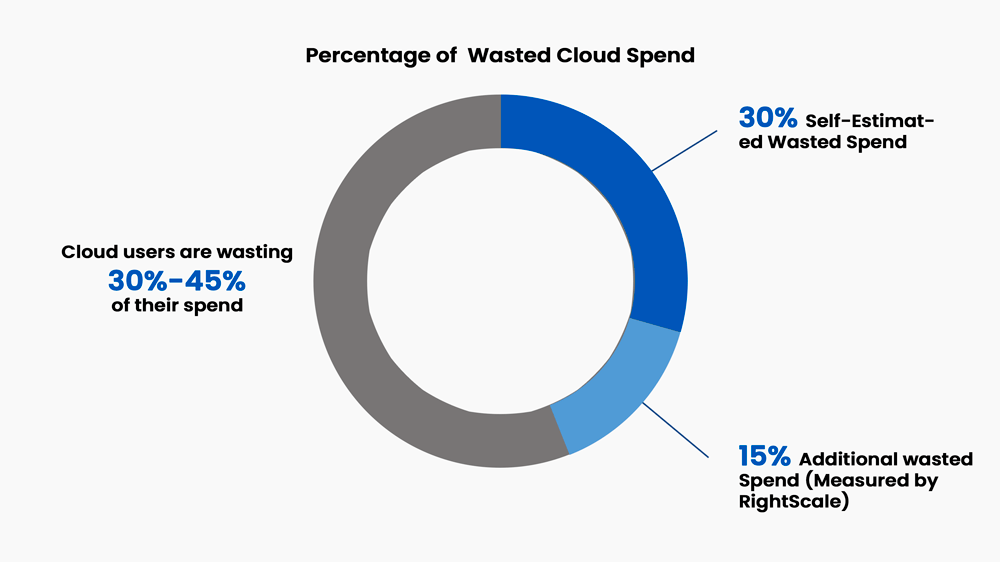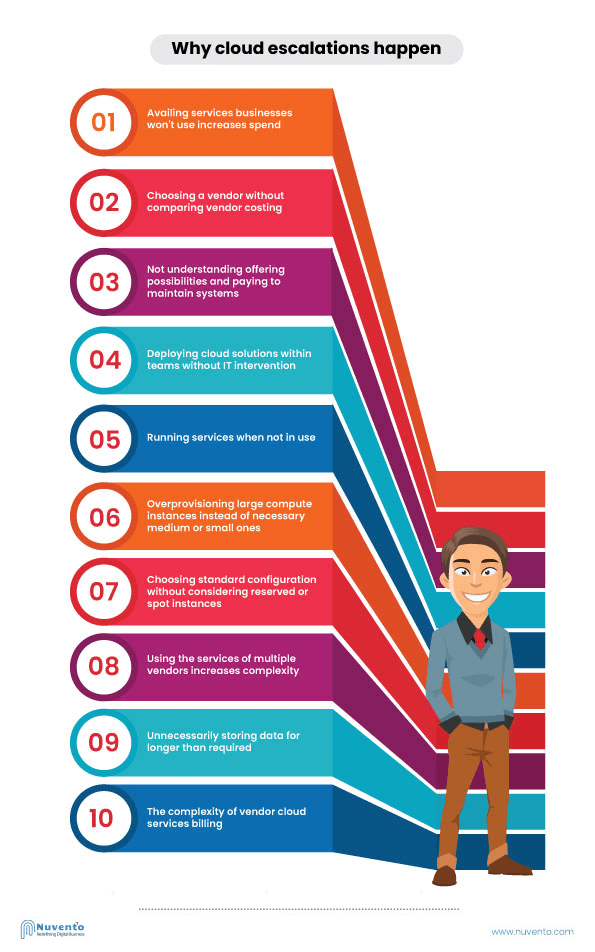
16 Jul Managing cloud spend to cut costs and increase business productivity
Managing cloud spend to cut costs and increase business productivity
Today, most businesses have at least one workload running on the cloud.
This year around, COVID 19 too has been one of the major accelerators for cloud adoption with 40% of businesses moving their operations for business continuity from distributed environments.
Cloud lets companies increase their capacity without investing in hardware and facilities, are reliable and available.
Why the move to the cloud?
A Deloitte survey of about 500 IT executives has found that security and data protection are the top drivers for cloud adoption.
58% of respondents ranked it as the number 1 driver and top-of-mind factor for cloud adoption.
Data modernization is the number 2 driver, involving moving data from legacy architecture to modern cloud databases.
Another significant driver is cost and IT operations that enable operational agility and efficiency.
However, to tap into these benefits, business must adopt the right approach to cloud and invest in setting up the infrastructure that improves the efficiency of their operations.
But just how much should you spend on your cloud infrastructure?
Is your new system built to improve your productivity?
To answer these questions, let’s first look at how cloud systems are priced and the need to manage cloud spend.

Managing cloud spend
A 2020 Flexera State of the Cloud Report has found that 30% of Cloud spend is wasted.
The survey results prove that optimizing cloud spend should be a priority initiative for enterprises.
Top reasons for escalating cloud costs were identified as availing services businesses don’t use, choosing incorrect instances, failing to use discounts, lack of centralized management, multi-cloud strategies, poor storage management and vendor lock-in.
To counter these factors businesses must leverage few measures that help optimize cloud spending like assessing infrastructure, turning on autoscaling, using the cloud vendor’s management tools, taking advantage of discounts, using serverless services, deploying containers, implementing automation solutions and using a cloud cost management vendor.
How cloud optimization helps to save instantly
In a cloud environment, resources can be optimized unlike in a legacy environment.
In a legacy environment, you’ve already paid for the hardware systems so there’s no impetus to make virtualized environments more efficient.
But with cloud, optimizing resources lets you immediately save costs. For instance, when you scale down a resource, it lowers your bills.

Why cloud costs escalations happen
1. Availing services businesses don’t use: Businesses sometimes avail services they most likely will not use owing to a lack of understanding of the environment and guidance from a cloud cost management expert.
A lack of guidance can have them spending more on their cloud infrastructure than what is required.
2. Choosing the wrong vendor: While most major vendor pricing charts look similar, going deep into it could reveal how some vendors charge nominally for some workload types.
To leverage the best of cloud’s offerings, organizations must ensure they fully understand public cloud pricing.
3. Vendor lock-in: Moving workloads from one vendor to another should be easy.
But it isn’t.
So, if organizations do not invest time in fully understanding the possibilities of the vendor offering, they will have to pay more to maintain systems on the framework because it’s difficult to migrate applications or workloads once they are in production.
4. Working in silos: When small teams or individuals within an organization deploy cloud solutions for their work without IT intervention, it makes it difficult for enterprises to know the expenditure on cloud.
5. Running services when not in use: In certain instances, users may turn on certain services which they then don’t turn off.
These instances may continue running even when no one is actually using them.
6. Choosing the wrong vendor: While most major vendor pricing charts look similar, going deep into it could reveal how some vendors charge nominally for some workload types.
To leverage the best of cloud’s offerings, organizations must ensure they fully understand public cloud pricing.
7. Selecting the wrong type of instances: Overprovisioning large compute instances instead of a necessary medium or small is one type of overspending that’s hard to spot.
8. Not availing discounts: When developers are in a hurry to launch their applications, they may choose the standard configuration settings without looking at reserved or spot instances that could save them money.
9. Multi-cloud approach: Many organizations choose to avail services from multiple vendors, matching applications and vendor offerings to find solutions that fit best.
However, using services of more than one vendor maintaining the environment complex and costly to manage.
10. Inefficient storage management: Unnecessarily storing data for longer than required can be a reason that increases cloud costs.
Also having multiple copies for recovery purposes saved on the cloud can increase spend. Organizations must ensure they are managing their storage efficiently and not spending on storage for data that is rarely accessed.
11. Not understanding cloud pricing and billing: One of the main reasons for cloud wastage is the complexity of their billing.
Expert consultation is one way to understand pricing and track where you’re spending money.

Where can you save cloud costs?
Instances
The most wastage happens for compute instances and virtual machines.
- Over-provisioned instances: 56% of cloud spend is on instances. However, 40% instances are a couple of sizes larger than what’s required for the workloads, which converts to 50%-75% wastage on each oversized instance. Save here, and see 20%-30% savings in instance spend or 11%to16% of all cloud spend
- Idle instances: Running cloud instances 24×7, even when they are used only 12X5 takes up much of your costs. Switching these instances to a 12×5 model saves 67% of costs. Temporary instances used for development, QA, training and so on are not terminated after project completion. Shutting this down could help realize savings.
- Going for high-cost instances or regions: Selecting vendors from nearby regions to support instances can help in saving costs. Prices vary for different regions and instance types, so evaluate your options. When new instance types are offered, with better specs and less costs, replace them with the older alternatives for significant savings.
Storage
Although storage costs are a 10%-25% of your cloud bills, it is something that can quickly grow and drive costs. So, uncover and eliminate wasted storage costs.
- Accumulated unattached volumes: When an instance is terminated, volumes attached are often not deleted. These volumes accumulate as instances are stopped and started, causing significant cloud wastage if not managed.
- Old snapshots: Snapshots are created for storage volumes, and so not cleaned up often. Organizations have their special policies for how long snapshots must be retained. A cloud infrastructure expert like Nuvento can help with automating this process.
- Expensive storage options: Cloud users tend to use expensive disks, redundancy options or access frequency. An expert consultant can help to identify the best cloud options to avoid overspending.
Instance discounting
You can commit to instance usage and leverage cost discounts provided by the cloud provider. While rules and approach to discounts vary for every provider, the basic principles for using the discounts are the same.

How to reduce your cloud bills and manage cloud spend
Identifying mismanaged resources, eliminating waste, reserving capacity for higher discounts and right sizing computing services to scale is the first, yet the challenging step for enterprises. Though the cloud offers unlimited scalability and lower IT costs, management and optimization are key to manage spend.
 1. Identifying unused or unattached resources: Finding unused and unattached resources is the easiest way to optimize cloud costs.
1. Identifying unused or unattached resources: Finding unused and unattached resources is the easiest way to optimize cloud costs.
There could be a temporary server that the administrator forgot to turn off or storage attached to terminated instances to be removed.
These usages result in increased charges of cloud resources once purchased but no longer used on your bill. Your cloud optimization strategy, therefore, should start by identifying unused and unattached resources and removing them.
2. Rightsizing services: Analyzing computing services and using them in the most efficient size is what rightsizing is all about.
Sizing instances can be challenging with cloud administrators having over 1.7 million possible combinations to choose from.
Using rightsizing services can recommend changes across instance families. It reduces costs and optimizes your cloud infrastructure.
3. Finding idle resources: Enterprises billing 100% for idle computing instances is creating significant wastage.
A key optimization strategy would be to identify such instances and consolidating computing jobs into fewer instances.
4. Making use of heatmaps: Heatmaps visually show peaks and valleys in computing demand.
This information can help in establishing start and stop times to reduce costs.
Leveraging automation to schedule instances to start and stop can help optimize costs.
5. Invest in reserved instances (RIs): Invest in RIs for long-term cloud plans.
These are larger discounts based on upfront payment and time commitment.
RI savings can go up to 75%, so this is essential for cloud cost optimization.
6. Spot instances: Spot instances are available for auction and, if the price is right, are purchased for immediate use. Spot instances however are short-lived and so can be used for jobs that can be terminated fast, which are common in most organization.
This makes spot instances a must have for cloud cost optimization.
Final thoughts
Organizations on the cloud are realizing that they need cloud spend management.
While some organizations need to optimize their existing services to control spend, some others, who are new to cloud, need to put in place appropriate reporting and controls to prevent cloud waste.
Leveraging services of an expert in cloud solutions like Nuvento can help organizations make the most of their cloud environments and save costs with cloud optimizations.
